This 14 night Complete Southern tour travels throughout the Southern region of Ireland
This comprehensive tour of Southern Ireland from the east coast to the west, along the south and through the Irish midlands, ensures that you never feel rushed as you go about discovering the stunning sights of each region. And you will also see part of the Wild Atlantic Way a stunning coastal route along Ireland’s western coast.Starting out with two full days in Dublin you’ll have plenty of time to take in Ireland’s capital before discovering all that Ireland’s south and west coasts have to offer from wonderfully picturesque towns like Westport and Clonakilty to scenic delights such as the Ring of Kerry and the Burren Region.
This tour is perfect if you want to take things at your own pace, see all of southern Ireland’s most loved attractions and maybe even find a piece of hidden Ireland for yourself.
Overnight Locations
Night 1 & 2: Dublin
Night 3 : Ballina , Mayo
Night 4 : Westport, Mayo
Night 5 : Clifden, Connemara
Night 6 : Galway City
Night 7 : Limerick
Night 8,9 & 10 : Killarney, Kerry
Night 11 : Clonakilty , Cork
Night 12 : Kilkenny
Night 13 & 14 : Dublin
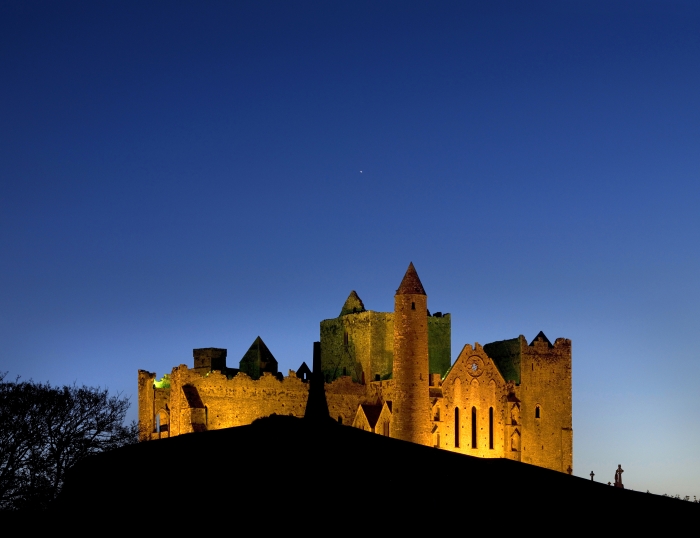
| Low Season | B&Bs | 3* Hotel | 4* Hotel |
| Bed & Breakfast for 14 nights and Rental of an Economy Manual Car | €870 pps | €1,186pps | €1,478 pps |
| High Season | B&Bs | 3* Hotel | 4* Hotel |
| Bed & Breakfast for 14 nights and Rental of an Economy Manual Car | €1,153 pps | €1,651 pps | €1,878 pps |
Tour package Includes :
- Economy Manual vehicle eg., Ford Fiesta with unlimited mileage based on a minimum of 2 people travelling together Inclusive of : Collision Damage Waiver (CDW), theft protection (TP), government tax (VAT) and Location Service Charge.(Upgrade rates for larger or automatic transmissions are available on request)
- Full breakfast daily except on day one
- All local taxes and hotel service charges
- Confirmation documents for each of your accommodations including driving directions
- All rates above are per adult sharing, child and single supplements apply
- Low Season- November-March
- High Season- April-October
Day 1 : Arrive Dublin
Welcome to Ireland and to Dublin, the capital City! Upon your arrival in Dublin, make your way to your overnight accommodation. Dublin is the capital of Ireland and one of Europe’s most vibrant cities , it is knee deep in history and has its own unique sense of humor.
The Dublin Hop on Hop Off Bus is an excellent way of visiting many of Dublin’s most historic locations .The all day ticket means you can hop on and off as often as you wish throughout the day allowing you explore the history and culture of Dublin at your leisure.
This evening, why not spend some time in the Temple Bar area. This small area boasts a dazzling choice of restaurants, cafes, bars and shops to suit all tastes and pockets, all within easy walking distance of Temple Bar’s many cultural centres and galleries. Its narrow cobbled streets are pedestrianised and are ideally suited to a leisurely stroll through the quarter. There is also the opportunity to experience an evening’s entertainment at any one of a number of excellent traditional Irish shows.
Day 2 in Dublin
Today you are free to explore Dublin City. Items to see in Dublin are: Trinity College i, The Book of Kells was written around the year 800 AD and is one of the most beautifully illuminated manuscripts in the world. It contains the four gospels, preceded by prefaces, summaries, and canon tables or concordances of gospel passages.
St Patrick’s Cathedral is traditionally the site of a holy well used by St Patrick for baptisms and a church was established here as early as the late fifth century – a stone marking the site of the well was found in 1901 after the demolition of buildings nearby to form the park beside the cathedral.
The new Guinness Experience is located in the heart of the Guinness brewery in Dublin. It is a dramatic story that begins over 250 years ago and ends in Gravity, the sky bar, with a complimentary pint of Guinness and an astonishing view of Dublin.
The National Museum of Archaeology and History displays many beautiful artefacts from throughout Ireland’s history.
Of course, you may wish to take time out to shop in Grafton Street or any one of a number of narrow and quaint streets that the café strewn city centre has to offer.
Overnight & Breakfast in Dublin
Day 3: Dublin to Ballina , Mayo
Today you will depart Dublin travelling on the N4 as far as Longford town and then onto the N5 towards Ballina. Why not stop at Strokestown House just 23km from Longford. Continue onwards towards Ballina, stopping at Foxford Woollen Mills. Your journey today stops in Ballina, which is Mayo’s largest town and home of the famous River Moy, There is a rich variety of pubs, restaurants and nightclubs in the town, which is famous for its hospitality and excellent accommodation base.
Day 4 – Ballina – Westport
This morning, depart Ballina and travel on the N59 through Crossmolina, Bangor Erris, Mulrany and take the R319 onto Achill Island. Located off the coast of County Mayo, Achill is Ireland’s largest island. It is joined to the mainland by a bridge at Achill Sound. The island measures approx. 15 miles East to West and 12 miles North to South, covering an area of approximately 60 square miles. With its Atlantic location, five Blue Flag beaches and breathtaking mountain landscape, Achill provides an unrivalled arena for outdoor activities and watersports of all types .
Depart Achill and travel on the N59 towards Westport. On the outskirts of Westport is Westport House. Continue onwards towards Westport town. The charming town of Westport is designated as a heritage town and is attractively located near the sea with Croagh Patrick as an impressive backdrop.
Day 5 Westport – Clifden
Depart Westport and travel south on the N59 through Liscarney, Carrowkennedy and Leenane and onwards to Kylemore Abbey (approx 50km). Kylemore Abbey is a Benedictine monastery founded in 1920 on the grounds of Kylemore Castle, in Connemara, County Galway, Ireland. The abbey was founded for Benedictine Nuns who fled Belgium in World War I .Continue your journey through the Connemara region with it’s stunning patchwork of bogs, lonely valleys, mountains and lakes, and only the odd remote cottage or castle hideaway for company. Upon arrival into Clifden , take a stroll through the village and peruse the many shopping choices from sweater shops, quality gift shops, boutiques to antique and souvenir shops.
Day 6 Clifden – Galway city
Galway city is an experience to be savoured and remembered. The historic city of the tribes dances to a beat uniquely its own. There is certain chemistry and vibrancy to this friendly University City, which many delight in, and few forget. Music, festivals, horse racing, pubs, restaurants, shops, theatres and most of all Galway people, combine to create this atmospheric mediaeval city of culture. Time permitting visit Galway Crystal factory, where you can learn the history of Claddagh Village, the birthplace of the world famous Claddagh Ring, a symbol of Love, Friendship and Loyalty.
Day 7 Galway – Limerick
Depart Galway and travel south on the N18. At Kilcolgan take the N67 towards Ballyvaughan and the Burren region. The Burren is of huge international significance for three reasons – geological, botanical and archaeological. Cliffs of Moher are one of Ireland’s top Visitor attractions. The Cliffs are 214m high at the highest point and range for 8 kilometres over the Atlantic Ocean on the western seaboard of County Clare. Your journey today finishes in Limerick – the capital of the Shannon Region and the third largest city in the Republic of Ireland. Limerick, with a charter older than London, has retained much of its historical past in attractions such as the Treaty Stone, King John’s Castle and the Hunt Museum .
This evening, why not visit Dolan’s Pub, Dock Road, Limerick where there is traditional Irish Music every evening.
Day 8 Limerick – Killarney
After breakfast take the N21 towards Adare Village. Adare is regarded by many a seasoned traveller as Ireland’s prettiest village with its charming thatched cottages, manicured public park and ancient church.
On to Killarney, with its three famous lakes and majestic mountain ranges. Killarney has been the inspiration of poets and painters over many centuries & the Killarney National Park is internationally renowned both for its scenic beauty and scientific interest.
Day 9 Killarney: Gap of Dunloe
The Gap of Dunloe is a narrow mountain pass formed by glacial ice a couple of million of years ago. The valley winds its way for 6 miles (10km) between Macgillycuddy’s Reeks and the Purple Mountains. Along the way it passes five lakes, or loughs, Coosaun Lough, Black Lake, Cushnavally Lake, Auger Lake, and Black Lough. The River Loe connects the lakes. Over the river at one end is the Wishing Bridge where it’s promised that wishes made while crossing the bridge will come true. At one end of the valley is Kate Kearney’s Cottage, these days it can be very busy but useful for a snack and restroom. At the other end is Lord Brandon’s Cottage from where you can get a boat back to Killarney.
The best way to explore the gap is by hiking through or riding a bicycle. No cars are allowed but you can go by pony-trap. These seat four people and roll slowly through the valley the old-fashioned way. They are operated by the local families who live along the Gap of Dunloe, the Gap Poneymen, and they have been providing this service since the 1920s. As you can imagine, the ride comes with plenty of story-telling and information.
Overnight & Breakfast in Killarney
Day 10 – Day trip to Dingle or Leisurely day – your choice!!
Today you have the choice of having a relaxing day in Killarney or maybe take a walk around Killarney National Park. However you could take a day trip to the fishing town of Dingle as well as the dramatic Dingle Peninsula. The Dingle Peninsula has more interesting antiquities, historic sites and varied mountain scenery than any other part of Ireland. Dingle is the most westerly town in Europe and attracts large numbers of visitors each year, many of whom come to learn the Irish language in the surrounding ‘A Flor-Gaeltacht’ – Irish speaking district. On route stop in the village of Annascaul, the birth place of Jerome Connor, the famous sculptor, and Tom Crean, a local hero who accompanied Scott and Shackleton on three Antarctic expeditions, including Scott’s doomed attempt to reach the South Pole. On his return to Annascaul Crean opened the “South Pole Inn”, which is still in business today. Minard Castle is also well worth a visit. The castle is said to have been built by the Knight of Kerry and is the largest fortress on the peninsula. In Dingle take time to visit one of their very unusual pubs such as Dick Macks, which is half a leather shop and half a pub so you can buy a pint and a purse at the same time or Foxy John’s which is a hardware store and pub combined – an unusual arrangement to say the least !
Overnight & Breakfast in Killarney
Day 11: Killarney – Clonakilty
Today you will take a wonderful journey along the coast N71 from Killarney through Kenmare and onto Glengarriff. Glengarriff, one of Ireland’s most beautifully situated villages and is one of the few remaining areas in Ireland which still has some of the original oak forest that covered the country. Continue south towards Bantry. Bantry House & Gardens is well worth a visit. Occupied by the White family since Richard White purchased it in 1739; the house contains furniture, paintings and other objects d’art collected by Richard White, the 2nd Earl of Bantry, on his extensive travels to Europe during the 19th century.
Clonakilty has been designated as West Cork’s Heritage Town by Board Failte, and a visit to the town soon shows why. You’ll feel at home here among the attractive traditional shop fronts and hand painted signs in English and Irish. The Post Office is housed in an old Presbyterian church and the Town Council and Library in a converted Corn Mill with the river flowing beneath. Narrow streets and lanes open into elegant squares. It is a town of tall spires, towers and historic buildings – the brewery buildings, the mills and the quayside warehouses, telling of the town’s busy trading and industrial past.
Day 12: Clonakilty – Kilkenny
Today you will travel to Kilkenny via Cashel. The Rock of Cashel was once the seat of the Kings of Munster and capital of this southern province. Kings of Ireland as well as Munster came to this spot and St. Patrick is known to have preached on the rock and converted the local King, Aenghus, here in the 5th Century. Brian Boru was also crowned King of Ireland on this spot in the early 11th Century. King Cormac built his superb Royal Chapel in the 12th century. From Cashel travel to Kilkenny city which is known as the Medieval city. Kilkenny is characterised by beautifully restored old buildings and winding slipways, it is small and compact enough to explore on foot, yet full of fascinating historical buildings and contemporary shops, design galleries and restaurants.. By night Kilkenny comes alive as visitors and locals alike enjoy the city’s vibrant cultural and he week, so whether your taste is for dance music, poetry, theatre or rock – Kilkenny has something to offer you!
Day 13: Kilkenny – Dublin
Today we recommend that you visit the Wicklow area. Wicklow known as the garden of Ireland, is a natural scenic wonderland, a landscape rich in breathtaking scenery. There are long sandy beaches which stretch enticingly along the length of the east coast. Wicklow is also a land of majestic mountains and spectacular valleys and is famous worldwide for the beautiful Glendalough, Continue from Glendalough on the N11 to Powerscourt House & Gardens, located just off the N11 near Enniskerry. Your journey today finishes in Dublin.
Day 14: Dublin – Boyne Valley
We would recommend that you take a tour of the Boyne Valley in North Dublin. The Boyne Valley and its surroundings, situated some 20 miles north-west from Dublin, is one of the most important Irish locations as far as historical heritage is concerned, from pre-celtic to medieval times.
For your final evening in Ireland, why not take in a visit to the Shindig night at the Old Jameson Distillery Your evening begins with a drinks reception and guided tour of the distillery. Guests may also join a whiskey tasting session. This relaxed evening includes Irish music and “craic” and also contemporary “Riverdance” style dancing, paired with a delicious meal.
Day 15
Return Flight Travel to the airport in Dublin for your return flight home.
Kilkenny Castle 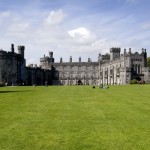
This iconic location attracts close to one million visitors per year. The unusual, underground visitor centre also houses the exciting Atlantic Edge display. This huge, domed cave contains images, exhibits and displays. The centre also has a gift shop stocking official Cliffs of Moher products, maps, guides, books and DVDs, visitor information and an accommodation booking service. Other facilities of this fully wheelchair accessible premises include a baggage store and ATM. Friendly staff will answer questions, provide assistance, give information on and directions to other attractions in the area.A 12th century castle remodelled in Victorian times and set in extensive parklands which was the principal seat of the Butler family, Marquesses and Dukes of Ormonde. Due to major restoration works, the central block now includes a library, drawing room, and bedrooms decorated in 1830’s splendour, as well as the beautiful Long Gallery. A suite of former servant’s rooms is the Butler Art Gallery, which mounts frequently changing exhibitions of contemporary art. The Parade Tower is the Castle’s conference venue.
Cliffs of Moher 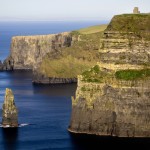
The Cliffs of Moher, one of Ireland’s top visitor attractions, loom high over County Clare’s west coast. Standing 214 metres at their highest point, the cliffs stretch for 8km along the Atlantic coastline. From the cliffs, one can see the Aran Islands, Galway Bay, The Twelve Bens, the Maam Turk Mountains in Connemara and Loop Head to the south. O’Brien’s Tower, another of Ireland’s most photographed landmarks, guards one prominent headland of these majestic cliffs. The Burren and Cliffs of Moher region of north Clare has been awarded the prestigious designation of membership of the UNESCO supported Global Geopark network at the 10th European Geoparks Conference in Langesund, Norway. This iconic location attracts close to one million visitors per year. The unusual, underground visitor centre also houses the exciting Atlantic Edge display. This huge, domed cave contains images, exhibits and displays. The centre also has a gift shop stocking official Cliffs of Moher products, maps, guides, books and DVDs, visitor information and an accommodation booking service. Other facilities of this fully wheelchair accessible premises include a baggage store and ATM. Friendly staff will answer questions, provide assistance, give information on and directions to other attractions in the area.
The Rock of Cashel 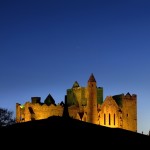
The Rock of Cashel is on a rocky plateau that rises 300 feet above the surrounding plain known as the Golden Vale of Tipperary. The name Rock of Cashel comes from the Gaelic “caiseal” which means “stone fort,” and it has been a known fortified position since the forth century of the Common Era.
From this promontory much of Country Tipperary is visible for miles, making it an ideal place for a fort or strong hold owing to the fact that a defender could see an enemy force approaching from any direction. Today, the visitor turning away from the magnificent view comes face to face with a maze or labyrinth of the remains of an ancient church open to the sky and weather, foundation stones of old buildings, tombstones, a ninety foot high stone tower and archways leading nowhere.
Although occupied since the fourth century, the visible ruins that one sees today only date to the twelfth and thirteenth centuries. The oldest edifice on the Rock that is still standing is a round tower of fitted stones, without mortar, built in 1101. Recently the base had to be reinforced with mortar to stabilize it. Such towers, which can be seen throughout Ireland, served as both watch towers and shelter from Viking raiders. The first floor entrance, reached by a ladder which could be pulled up in the event of attack, was twelve feet above the ground.
Muckross House & Gardens 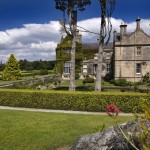
This magnificent Victorian mansion – one of Ireland’s leading stately homes – is situated amidst the spectacular scenery of Killarney National Park in County Kerry. The elegantly furnished rooms portray the lifestyles of the landed gentry, while downstairs in the basement you can experience the working conditions of the servants employed in the House back in the day.
Muckross House is also home to a number of skilled craftworkers, who can be seen using skills in the crafts of weaving, pottery and bookbinding. Many exotic trees and shrubs flourish in the mild climate and sheltered location of the Muckross gardens. Attractive features include a fine collection of rhododendrons and azaleas, an outstanding rock garden on a natural rock outcrop and beautiful tree-fringed lawns.
